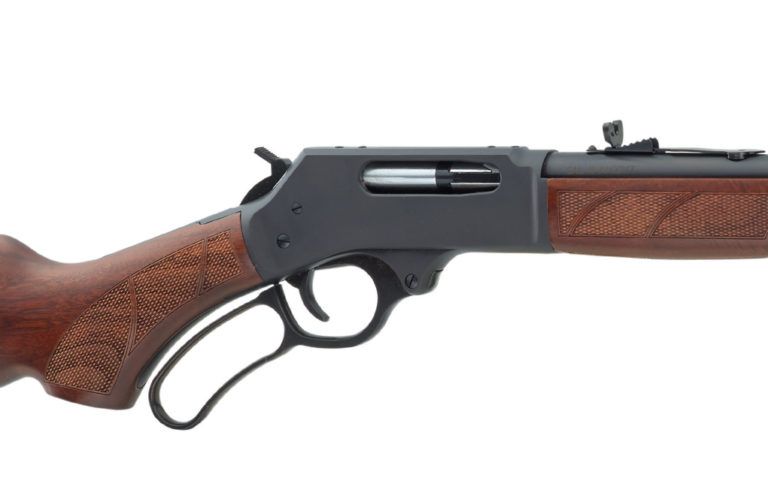
Economical, effective and just plain powerful, the Henry .45-70 is the epitome of a modern big-bore lever-action.
Why the Henry .45-70 steel is among the best:
- 18-inch barrel Guide Gun configuration.
- 7-pounds, light enough for ease of carry.
- Enough mass to mitigate recoil.
- 4-round capacity.
- Now features a side loading gate for fast reloads.
- Capable of single-round loading through ejection port.
- American walnut stock and richly blued metal components.
- Semi-buckhorn sights for fast target acquisition.
- Diamond insert draws eye to rear sight's notch.
- Capable of handling all but the hottest and longest .45-70 loads.
- Viable hunting rifle for every species on earth with proper ammo and where legal.
Updated 1/5/21
Big hunks of metal.
Plain and simple, it’s what captures the imagination of big bore enthusiasts, sends their hearts aflutter and makes them more than willing to endure, in many cases, mule-kick level punishment. The abuse is worth it, painfully satisfying some might say. A rifle at the shoulder proficient enough to plant anything that might tread upon God’s green earth like it’d been struck by his wrath, that’s mighty reassuring… even addictive.
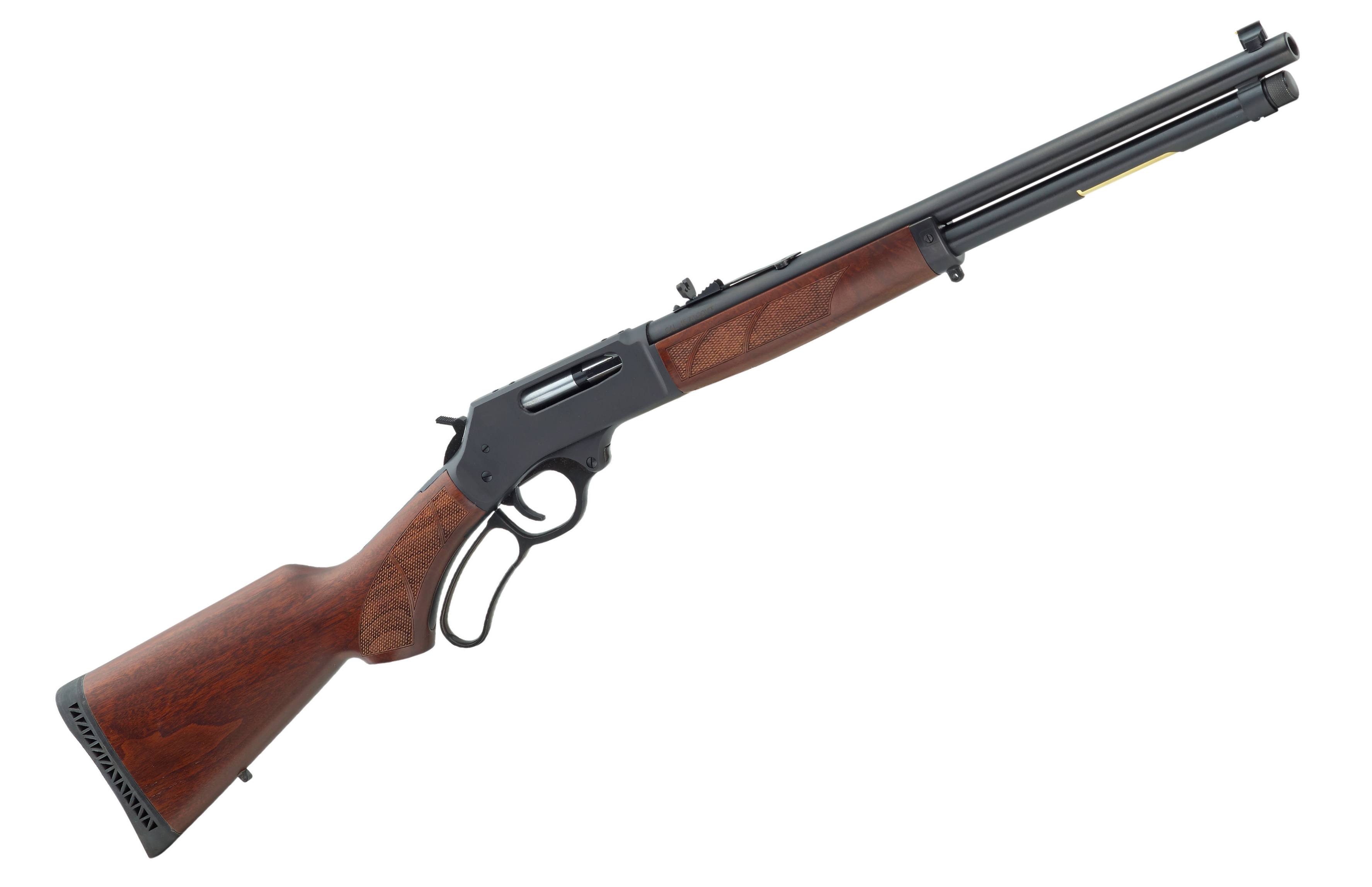
While there are many behemoths worth celebrating, if you have an ounce of Yankee blood pumping in your veins then it’s a fair bet you have a soft spot for a big-bore legend born and breed on our own soil. The .45-70 Government still reeks of bison dung and can’t help but stir the fancy of a simpler time, when lone men carved the nation one trigger-pull at a time.
Arguably outclassed in the modern era, the one-time military cartridge soldiers on 145 years since its advent and continues to prove its mettle. There isn’t a critter from the Yucatan to Yukon Territory and beyond it can’t handle. And, since its rebirth in the early 1970s, there’s no better time to fall in love with the old warhorse than now.
Lever-actions — that most American of rifles — have saved the .45-70 Gov’t. from obscurity. In the process, they've armed hunters with a round in the upper echelons of potency, and a way to deliver it at just short a Gatling-Gun rate. And of the choices of the iconic rifles chambered for the big-bore bruiser today, few offer the class and performance of the Henry .45-70.
Henry And The .45-70 Government
Introduced this past decade, the .45-70 has become among the company’s most popular calibers. In all, the New Jersey gunmaker offers five repeaters in the caliber, which beyond the original brass and steel models includes the All-Weather, Color Case Hardened, Steel Wildlife Edition and Brass Wildlife Edition. More recently, the gunmaker’s newish Single Shot break-action rifle line has also gone the way of the Government.
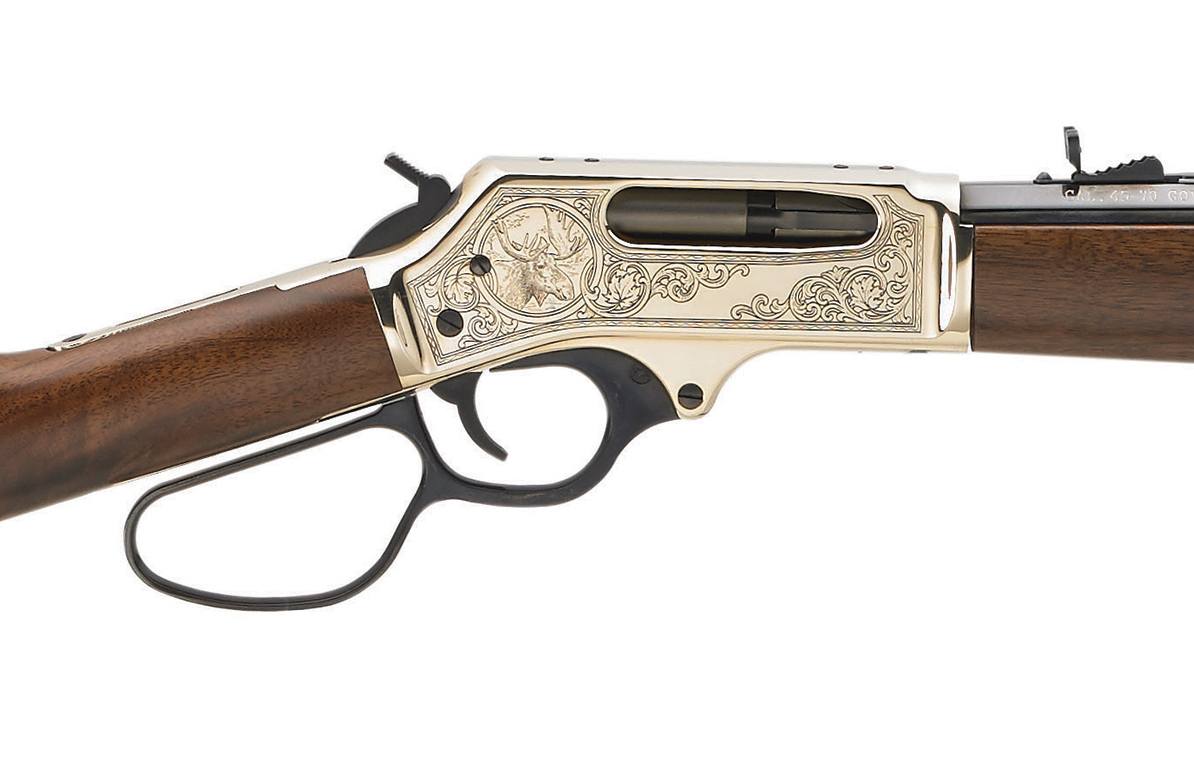
With typical Henry flourish, there are plenty of embellishments available for the shooter who requires a functional firearm with wall-hanger good looks. From rich engravings and inlays, classic octagon barrels, longer 22-inch barrels and hard-chrome plating (All-Weather), the company offers an impressive selection of fairly economical upgrades. But the pennywise shooter might get the gem of the pack.
Elegantly utilitarian, the original steel model is quite possibly the best of Henry’s big-bore repeaters available today, and not simply due to its reasonable-for-class $969 MSRP. Sized right and made with Henry’s usual eye toward quality, the completely American made rifle offers most everything shooters desire in a modern-day .45-70 lever-action.
How Henry Struck Gold With Steel
Not that long ago, the Government was shot from rifles equal in stature to the cartridge itself. Lengthy barrels, 20-inches plus, were the standard. Effective, but unwieldy. It was as if gunmakers still envisioned sentinels on prairie bluffs taking long shots at bison herds. But in the era of high-velocity cartridges, the .45-70’s rainbow trajectory wasn’t as sexy as it was in its blackpowder days.
Leading the way in the late 1990s, Marlin re-envisioned what a .45-70 could and should be in the modern era when it introduced its 1895 Guide Gun. Nimble and fast, the shorter-barreled rifle was ideal for up-close snapshots delivered with all the authority and finality of judgment day. A 300- to 500-grain bullet moving upwards of 1,400 and 2,000 fps 100 yards in is a comforting security blanket against equally devastating threats — a brown bear charging from the elders or a bull moose with blood on his mind. It also made the .45-70 a much more practical option for African game, at least the variety that requires close stalking and a second or third shot to persuade the critter not to make you mush — that is, where it's deemed powerful enough.

This is where Henry began. Outfitted with an 18-inch round barrel, the steel Henry .45-70's swiftness tracking and acquiring a target is limited only by the man or woman behind the trigger. Furthermore, at 7 pounds, it’s lighter than many in its class without losing the heft required to make recoil manageable, thus allowing fast follow-up shots. (To be truthful, the low-pressure, straight-walled .45-70 cartridge is very shootable, with recoil a hair above the .30-06.)
All well and good, but unless home base is Alaska’s Kenai Peninsula, how many rouge coastal browns is the average hunter likely to encounter? Outside a zoo, admittedly not many. However, the big-bore cartridge is plenty capable of wearing more hats than last-second lifesaver. The odd branch or brush are mere afterthoughts for the cartridge when chasing pre-rut elk in tall timber. And while lesser calibers will, shall we say, bring home the bacon on a hog hunt, but there’s nothing quite as final or fun as big boring a boar. With sharp woodcraft and stealthy stalking, the Henry .45-70’s potential is restricted purely by the shooter him or herself, though rock chucks are a stretch.
Henry .45-70 Inside Out
If there’s a facet Henry has down pat in the art and science of gun making, it's aesthetics. This holds true even if you aim at one of their entry-level models. Walnut, bluing, sweeping gunny lines — they’re all there on every model turned out. With an eye-catching, fine-grained and checkered American Walnut stock and a rich finish up to most any environments short of blue-water naval service, the Henry .45-70 steel has the allure of a collector’s piece with field-gun performance. Additionally, there are the little extras that keep the rifle highly functional, while adding to its classic appearance.
For those who don’t utilize the drilled and tapped receiver, chief among these are the rifle’s iron sights. Originally the Henry .45-70 utilized a rear ghost-ring and white-striped front blade. Henry later switched gears to a system more familiar. Some might scoff at the semi-buckhorn rear sight as an upgrade, but it's difficult to quarrel over its speed once fully mastered. Complete with a diamond insert that draws the eye to the center of the notch and a bright brass bead on the front blade, the sight picture is frighteningly intuitive and quick as a heartbeat. To boot, it makes the big-bore look more “Henry.”

Thankfully, the gunmaker addressed the gun's main drawback. Previously, loading the Henry .45-70—like all the company's lever-actions — was a bear. All four rounds use to loaded through the rifle’s tubular magazine, which will set the impatient to jitters and raise two particular issues. First, topping off the magazine is a long process by today’s standards. Second, there’s really no safe way to load the rifle 4+1; no matter how you cut it, you’ll muzzle sweep your hand with a loaded chamber.
As of 2020, Herny broke from tradition and rectified this issue, introducing a side loading gate. Yeah, that's a Winchester addition to Henry's original design, but there have been few complaints from end-users. It breaks from Henry's original formula, but makes the rifle all the quicker and more appealing to modern shooters.
Now the main hitch in the Henry's giddyap — all lever-action Henry rifles for that matter — is trying the nerves of lefties. Considering there are no southpaw models and the ejection port is on the right, hot brass flying in front of even on to the bridge of the nose is a fact of life. That may be acceptable with Henry’s pistol-caliber Big Boy or .410 lever-action. But the .45-70 case is more than 2-inches in length, which ups the ante.
The other aspect of the Henry .45-70 — common to all the company’s wares — is that it does not have the dreaded cross-bolt safety (we’ll throw in an amen). This unfortunate side-effect of our warning-labels-on-buckets society might give lawyers a case of screaming abdabs, but for lever purists it's bliss. The safety conscious should fear not, because the gun is still secure to carry chambered, hammer down, thanks to a transfer-bar safety. In turn, the rifle is virtually ready to go the moment you are.
.45-70 Ammo
In recent times, Black Hills Ammunition released the first rifle round of its popular Honey Badger line. What chambering did they choose for the monometal wonder? Why the .45-70 Government, of course. Not only is this a testament to the longevity of the cartridge, but the growing potential of the caliber.
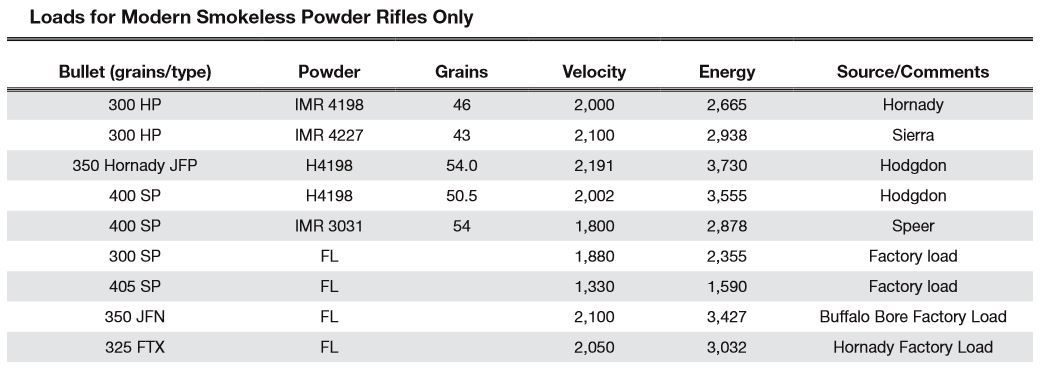
From relatively mild Black Hills’ 405-grain Cowboy Action to Hornady’s moderate 250-grain Leverevolution to hot Buffalo Bore 300-grain Magnum Lever-Action, ammo is abundant. So are bullet weights and styles, ranging from 250 to 500 grains. Shooters have the option of soft lead, hard-cast lead, jacketed hollow point, polymer tipped hollow point, monometal, etc. You won’t run short on shooting fodder.
However, .45-70 ammunition deserves a word of caution — not all of it works for all guns.
Given the longevity of the cartridge and firearms and ammunition advancements, some guns can’t handle what a particular round brings to the table. For instance, an old Springfield Trapdoor would pop like a firecracker with most modern ammunition. And some of the hotter and heavier dangerous-game loads will do the same to a lever-action. Heck, some won’t even chamber due to length.
Generally speaking, there are three ammunition categories for the .45-70: rounds meant strictly for old blackpowder rifles, rounds for modern lever-actions, and rounds tested for the Ruger No. 1 (which don’t work in the other two). Most ammunition companies are upfront about what works in what, and care should always be paid when shopping for .45-70 rounds.
Parting Shot
In the 1930s, the future appeared dim for the .45-70. The age of high-velocity cartridges appeared to have left the brute wallowing, with major gun manufacturers dropping the chambering from their lines. The cartridge was a few rusted actions away from a footnote in gun history.
Then something miraculous happened. Blessedly, modern man discovered his forefathers weren’t as ignorant as his high school history teacher promised and found age-old cartridges in age-old action designs could still hold their own.
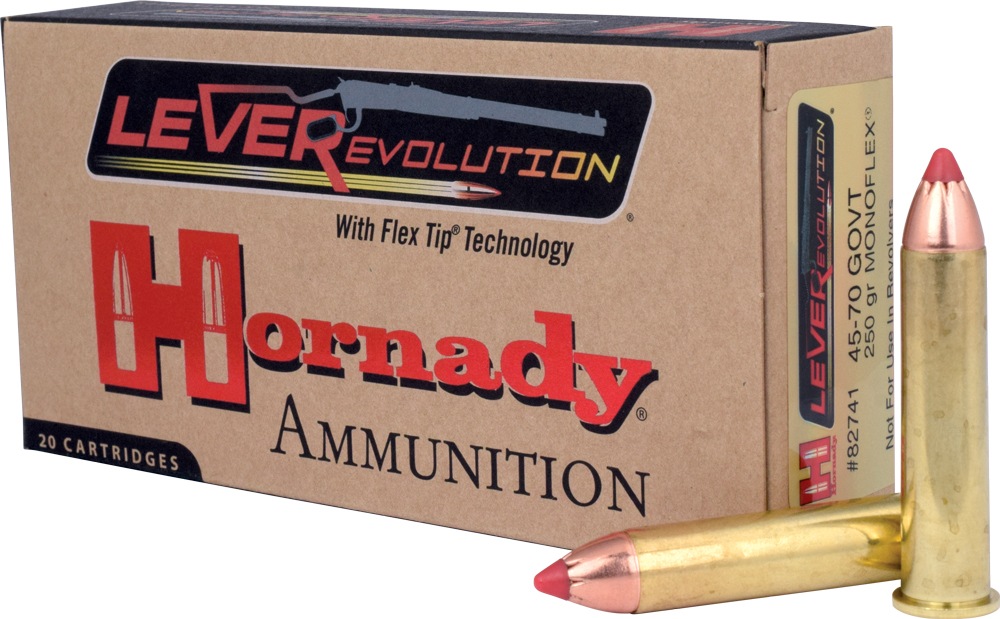
We were better for it. Some classic contemporary rifles were the result, chief among them the Henry .45-70. And one needn’t have his or her sights set on Africa’s Big Five or search out a buffalo hunt to appreciate what the New Jersey-born beast offers. A love for tradition and big hunks of metal, plus a stout clavicle are all that are required.
Henry .45-70 Steel Specs:
Barrel Length: 18.43 inches
Barrel Type: Round Blued Steel
Rate of Twist: 1:20
Overall Length: 37.5 inches
Weight: 7.08 pounds.
Receiver Finish: Blued Steel
Rear Sight: Fully Adj. Semi-Buckhorn w/ Diamond Insert
Front Sight: Brass Bead
Scopeability: Drilled and Tapped
Stock Material: American Walnut
Buttplate/Pad: Black Ventilated Rubber Recoil Pad
Length of Pull: 14 inches
Safety: Transfer Bar
MSRP: $969
henryusa.com

Next Step: Get your FREE Printable Target Pack
Enhance your shooting precision with our 62 MOA Targets, perfect for rifles and handguns. Crafted in collaboration with Storm Tactical for accuracy and versatility.
Subscribe to the Gun Digest email newsletter and get your downloadable target pack sent straight to your inbox. Stay updated with the latest firearms info in the industry.

![Best Concealed Carry Guns In 2025 [Field Tested] Wilson Combat EDC X9S 1](https://gundigest.com/wp-content/uploads/Wilson-Combat-EDC-X9S-1-324x160.jpg)


![Best 9mm Carbine: Affordable PCCs [Tested] Ruger Carbine Shooting](https://gundigest.com/wp-content/uploads/Ruger-Carbine-Shooting-100x70.jpg)
![Best AR-15: Top Options Available Today [Field Tested] Harrington and Richardson PSA XM177E2 feature](https://gundigest.com/wp-content/uploads/Harrington-and-Richardson-PSA-XM177E2-feature-100x70.jpg)
